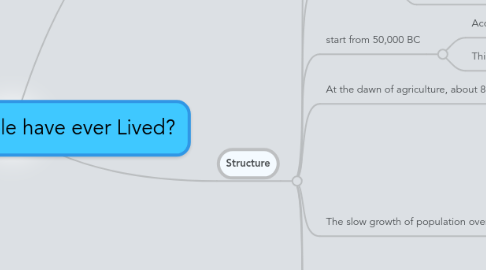
1. Source
1.1. Population Today 2002
2. Structure
2.1. Intro
2.1.1. One reason the question keeps coming up is that somewhere, at some time back in the 1970s, a now-forgotten writer made the statement that 75 percent of the people who had ever been born were alive at that moment.
2.1.2. sounds plausible since we believe most aspects of the 20th century are characterised by expo growth
2.1.2.1. This factoid has had a long shelf life, even though a bit of reflection would show how unlikely it is. For this "estimate" to be true would mean either that births in the 20th century far, far outnumbered those in the past or that there were an extraordinary number of extremely old people living in the 1970s.
2.1.3. What might be a reasonable estimate of the actual percentage?
2.1.3.1. limits
2.1.3.1.1. Any such exercise can be only a highly speculative enterprise, to be undertaken with far less seriousness than most demographic inquiries. Nonetheless, it is a somewhat intriguing idea that can be approached on at least a semi-scientific basis.
2.1.3.1.2. absolutely no demographic data available for 99 percent of the span of the human stay on Earth. Still, with some speculation concerning prehistoric populations, we can at least approach a guesstimate of this elusive number.
2.2. Prehistory
2.2.1. Any estimate of the total number of people who have ever been born will depend basically on two factors: (1) the length of time humans are thought to have been on Earth and (2) the average size of the human population at different periods.
2.3. start from 50,000 BC
2.3.1. According to the United Nations' Determinants and Consequences of Population Trends, modern Homo sapiens may have appeared about 50,000 B.C.
2.3.2. This long period of 50,000 years holds the key to the question of how many people have ever been born.
2.4. At the dawn of agriculture, about 8000 B.C., the population of the world was somewhere on the order of 5 million.
2.5. The slow growth of population over the 8,000-year period, from an estimated 5 million to 300 million in 1 A.D., results in a very low growth rate — only 0.0512 percent per year.
2.5.1. It is difficult to come up with an average world population size over this period. In all likelihood, human populations in different regions grew or declined in response to famines, the vagaries of animal herds, hostilities, and changing weather and climatic conditions.
2.5.2. One estimate of the population of the Roman Empire, from Spain to Asia Minor, in 14 A.D., is 45 million.
2.5.3. rates and such
2.5.3.1. Life expectancy at birth probably averaged only about 10 years for most of human history
2.5.3.1.1. Infant mortality in the human race's earliest days is thought to have been very high — perhaps 500 infant deaths per 1,000 births, or even higher
2.5.3.1.2. Children were probably an economic liability among hunter-gatherer societies, a fact that is likely to have led to the practice of infanticide.
2.5.3.1.3. Under these circumstances, a disproportionately large number of births would be required to maintain population growth, and that would raise our estimated number of the "ever born."
2.5.3.2. Under these conditions, the birth rate would have to be about 80 per 1,000 people just for the species to survive.
2.5.3.3. Today, a high birth rate would be about 45 to 50 per 1,000 population, observed in only a few countries of Africa and in several Middle Eastern states that have young populations.
2.6. By 1650, world population rose to about 500 million, not a large increase over the 1 A.D. estimate.
2.6.1. low because of Blacl Death
2.6.2. The average annual rate of growth was actually lower from 1 A.D. to 1650 than the rate suggested above for the 8000 B.C. to 1 A.D. period. One reason for this abnormally slow growth was the Black Death. This dreaded scourge was not limited to 14th-century Europe.
2.6.3. The epidemic may have begun about 542 A.D. in western Asia, spreading from there. It is believed that half the Byzantine Empire was destroyed in the sixth century, a total of 100 million deaths.
2.6.4. Such large fluctuations in population size over long periods greatly compound the difficulty of estimating the number of people who have ever lived.
